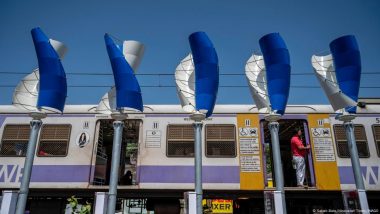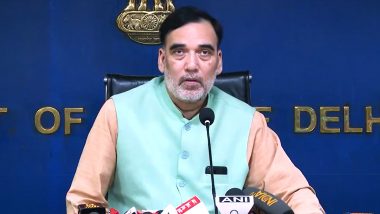Wind farms are key to a clean energy future, but expansion in green zones faces growing opposition. Wind turbines on buildings, rail lines or airports could be a breath of fresh air.Investment in renewable wind energy, in tandem with solar, is fast outpacing power produced by fossil fuels like coal or gas.
Also Read | India News | PM Modi Condoles Demise of Former Tamil Nadu BJP MP Thiru Master Mathan.
But wind farms demand much more space than non-renewable power plants.
Also Read | India News | Uttarakhand Rain: CM Dhami Urges District Magistrates to Stay on High Alert.
And it's becoming notoriously difficult to get planning approval to install towering wind turbines across rural landscapes. This is partly due to environmental protections, but also not-in-my-backyard opposition from local residents — often due to the aesthetic impacts.
Meanwhile, offshore wind projects require massive capital investment and are also facing backlash from coastal communities.
Instead of tending toward wind infrastructure in pristine countryside or in coastal waters, could wind energy also be harnessed in more developed industrial and urban areas?
Such location solutions would help countries like Germany that need to quickly ramp up clean wind energy capacity to meet climate goals.
With only 0.8% of Germany's land area approved for onshore wind energy as of 2023, the government wants to more than double installations to 2% by 2032 to achieve its renewable energy targets.
Winds of change in Belgium
Wind farms are so far less common in urban locations, since buildings obstruct and slow the high-speed wind required to power traditional turbines.
In high-density regions such as Flanders in Belgium, the difficulty of gaining planning permission for wind projects on open land has long forced investors to seek alternative locations in industrial areas such as ports and highways or next to power lines.
A wind farm has been created on the Zeebrugge ship ferry terminal in Belgium, for example, where commuters cross the North Sea to the UK and liquefied natural gas tankers also dock.
The permit process for the five turbines "went smoothly," said Tom Hautekiet, CEO of the Port of Zeebrugge, in 2021 of upcoming additions to the industrial wind facility. He added that such industrial harbor areas are an "ideal location" for wind farms, and that the port's wind energy capacity now amounts to 200 megawatts.
Wind-powered train networks pick up speed
Austria's national state railway has built what it says is the world's first wind turbine designed to generate power for electric train operation.
Located in the town of Höflein in Lower Austria, the 200-meter turbine feeds into the overhead electrification system and can power around 1,400 train journeys annually on the route between the capital, Vienna and the city of Salzburg.
The prototype wind turbine is just the beginning, said Austrian Rail, which wants to increase the share of self-generated electricity from renewable sources in the railway power supply to 80%.
Wind turbines are also being installed along railway tracks so that the gusts of wind generated by passing trains can be used to rotate the blades.
Indian rail company Western Railway has installed five small wind turbines that use vertical blades along tracks in Mumbai to generate energy. Now in the development phase, the rail provider hopes to expand the clean power technology to lower its carbon footprint across its subcontinental train network.
Jet planes rev up high-velocity energy
At Love Field airport in the US city of Dallas, Texas, prototype turbines harness wind from passing airplanes and convert them into energy.
The clean energy tech startup, JetWind Power Corporation, is working with the airport to test the potential to harness wind gusts, not only from commercial planes, but potentially from jet fighters taking off from aircraft carriers as they pass a caged pod containing three turbines.
For now, the energy generated by the turbines is being used to power electric cars at Dallas Airport. However, the prototype is set to expand and harness high-velocity wind from fast trains, in addition to speeding cars on motorways.
Alternative turbine designs for city spaces
While wind turbines with horizontal blades remain the efficient way to harness large-scale wind energy on open fields, a new wave of narrower devices employ horizontal blades to catch the wind in built-up or compact areas.
A French company, New World Wind, has accordingly created the Wind Tree that uses "Aeoroleaf" sheets shaped like leaves to noiselessly catch a stiff or weak breeze in urban settings.
Installed in a park, courtyard or on a street, the wind tree can power anything from offices to charging stations for electric cars.
Meanwhile, the omnidirectional, bladeless wind turbine dubbed O-Wind can harness winds from any direction.
The spinning orbs can be installed across urban buildings and infrastructure. The goal is to create clean energy within cities which, consume almost 80% of all electricity, according to the United Nations.
Edited by: Tamsin Walker
(The above story first appeared on LatestLY on Jul 27, 2024 05:00 PM IST. For more news and updates on politics, world, sports, entertainment and lifestyle, log on to our website latestly.com).













 Quickly
Quickly













 KKR
KKR



